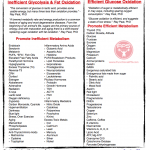Also see:
Universal Principle of Cellular Energy
Comparison: Oxidative Metabolism v. Glycolytic Metabolic
Comparison: Carbon Dioxide v. Lactic Acid
Carbon Dioxide Basics
Protect the Mitochondria
Quotes by Ray Peat, PhD:
“When we talk about increasing the metabolic rate, and the benefits it produces, we are comparing the rate of metabolism in the presence of thyroid, sugar, salt, and adequate protein to the “normal” diet, containing smaller amounts of those “stimulating” substances. It would be more accurate if we would speak of the suppressive nature of the habitual diet, in relation to the more optimal diet, which provides more energy for work and adaptation, while minimizing the toxic effects of free radicals.”
“These factors that impair respiration tend to shift mitochondrial metabolism away from the oxidation of glucose and the production of carbon dioxide, to the oxidation of fats and the production of lactic acid.”
“Reducing the toxic factors, relative to the restorative factors, should be the aim, rather than looking for another drug.”
“The arguments I have outlined for considering rosacea to be essentially a problem of metabolic energy, and the mechanisms that I mention for restoring mitochondrial functions, might seem more complex than Hoffer’s orthomolecular views. However, this approach is actually much simpler conceptually than any of the ideologies of drug treatment. It simply points out that certain excitatory factors can interfere with energy production, and that there are opposing “inhibitory” factors that can restore energy efficiency. Sometimes, using just one or two of the factors can be curative.”
=========================
The thumbnail below is a revisable chart that portrays factors that promote efficient or inefficient energy metabolism. The goal of the health conscious should be to maximize the effects of the promoters of efficient metabolism while minimizing the effects of the factors that lead to inefficient metabolism.
Some of the factors that promote inefficient metabolism do serve important functions during stress, but they should be used only intermittently until the stressor subsides. If they have a significant role in physiology relative to the factors that promote efficient metabolism, the human machinery starts to malfunction. Please check with a medical professional about all things related to your health. This chart does not represent medical advice in any way.


Thank you for compiling this chart!
Can you describe what breathing O2 from an O2 tank for like 5 hours a day would do to your CO2 levels? My mother has been told to do this to increase her mitochondrial health But I think it is causing low-grade hyperventilation.
Sarah, making more O2 available in serum isn’t going to do anything to improve aerobic metabolism. All she is going to do is lower CO2 concentrations which will *lower* efficiency of using oxygen.
Sarah, the O2 can’t be used without adequate CO2. I can’t say what it’s going to do specifically to your mother, but you can monitor her body temperature, pulse rate, oxygen saturation, temperature of the extremities, skin color, and overall wellbeing to determine its effects. Here is an outstanding quote about oxygen saturation from Dr. Peat from an email correspondence I had with him.
“I have noticed that when I’m most relaxed and at high altitude my oxygen saturation is in the range of 89% to 94%, lower with more relaxation. When I’m walking fast uphill, it is around 99% (I think that could mean that my fingers are consuming less). If my fingers are cold (i.e., not using much oxygen) the number is higher. If you pump blood through a cold corpse, the hemoglobin will stay 100% saturated.”